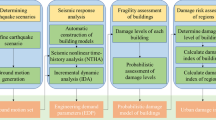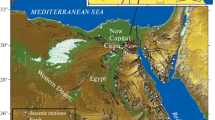Abstract
Strong aftershocks generally occur following a significant earthquake. Aftershocks further damage buildings weakened by mainshocks. Thus, the accurate and efficient prediction of aftershock-induced damage to buildings on a regional scale is crucial for decision making for post-earthquake rescue and emergency response. A framework to predict regional seismic damage of buildings under a mainshock-aftershock (MS-AS) sequence is proposed in this study based on city-scale nonlinear time-history analysis (THA). Specifically, an MS-AS sequence-generation method is proposed to generate a potential MS-AS sequence that can account for the amplification, spectrum, duration, magnitude, and site condition of a target area. Moreover, city-scale nonlinear THA is adopted to predict building seismic damage subjected to MS-AS sequences. The accuracy and reliability of city-scale nonlinear THA for an MS-AS sequence are validated by as-recorded seismic responses of buildings and simulation results in published literature. The town of Longtoushan, which was damaged during the Ludian earthquake, is used as a case study to illustrate the detailed procedure and advantages of the proposed framework. The primary conclusions are as follows. (1) Regional seismic damage of buildings under an MS-AS sequence can be predicted reasonably and accurately by city-scale nonlinear THA. (2) An MS-AS sequence can be generated reasonably by the proposed MS-AS sequence-generation method. (3) Regional seismic damage of buildings under different MS-AS scenarios can be provided efficiently by the proposed framework, which in turn can provide a useful reference for earthquake emergency response and scientific decision making for earthquake disaster relief.
Similar content being viewed by others
References
Amadio C, Fragiacomo M, Rajgelj S (2003). The effects of repeated earthquake ground motions on the non-linear response of SDOF systems. Earthquake Engineering & Structural Dynamics, 32(2): 291–308
Ancheta T D, Darragh R B, Stewart J P, Seyhan E, Silva W J, Chiou B S J, Wooddell K E, Graves R W, Kottke A R, Boore D M, Kishida T, Donahue J L (2014). NGA-West2 database. Earthquake Spectra, 30(3): 989–1005
Applied Technology Council (1985). Earthquake damage evaluation data for California. Final Report. Redwood City, CA: Applied Technology Council
Bommer J J, Martínez-Pereira A (1999). The effective duration of earthquake strong motion. Journal of Earthquake Engineering, 3(2): 127–172
Bommer J J, Stafford P J, Alarcón J E (2009). Empirical equations for the prediction of the significant, bracketed, and uniform duration of earthquake ground motion. Bulletin of the Seismological Society of America, 99(6): 3217–3233
CESMD (2019a). Berkeley Earthquake of 20 Oct 2011 (4.0 Mw, 14:41:04 PM PDT, 37.86 N 122.25 W, Depth 8.0 km). CESMD Internet Data Report
CESMD (2019b). Berkeley Earthquake of 20 Oct 2011 (3.8 Mw, 20:16:05 PM PDT, 37.87 N 122.25 W, Depth 9.6 km). CESMD Internet Data Report
Chen H, Xie Q C, Li Z Q, Xue W, Liu K (2017). Seismic damage to structures in the 2015 Nepal earthquake sequences. Journal of Earthquake Engineering, 21(4): 551–578
Chiou B, Darragh R, Gregor N, Silva W (2008). NGA project strong-motion database. Earthquake Spectra, 24(1): 23–44
Du W Q, Wang G (2017). Prediction equations for ground-motion significant durations using the NGA-West2 database. Bulletin of the Seismological Society of America, 107(1): 319–333
Federal Emergency Management Agency (FEMA) (2012). Multi-Hazard Loss Estimation Methodology—Earthquake Model, HAZUS-MH 2.1 Technical Manual. Washington DC: Department of Homeland Security, Federal Emergency Management Agency, Mitigation Division
Fragiacomo M, Amadio C, Macorini L (2004). Seismic response of steel frames under repeated earthquake ground motions. Engineering Structures, 26(13): 2021–2035
Goda K (2012). Nonlinear response potential of mainshock-aftershock sequences from Japanese earthquakes. Bulletin of the Seismological Society of America, 102(5): 2139–2156
Goda K, Salami M R (2014). Inelastic seismic demand estimation of wood-frame houses subjected to mainshock-aftershock sequences. Bulletin of Earthquake Engineering, 12(2): 855–874
Goda K, Taylor C A (2012). Effects of aftershocks on peak ductility demand due to strong ground motion records from shallow crustal earthquakes. Earthquake Engineering & Structural Dynamics, 41(15): 2311–2330
Haddadi H, Shakal A, Huang M, Parrish J, Stephens C, Savage W U, Leith W S (2012). Report on progress at the Center for Engineering Strong Motion Data (CESMD). In: The 15th World Conference on Earthquake Engineering. Lisbon, Portugal, 24–28
Hatzigeorgiou G D, Beskos D E (2009). Inelastic displacement ratios for SDOF structures subjected to repeated earthquakes. Engineering Structures, 31(11): 2744–2755
Hatzivassiliou M, Hatzigeorgiou G D (2015). Seismic sequence effects on three-dimensional reinforced concrete buildings. Soil Dynamics and Earthquake Engineering, 72: 77–88
Hori M, Ichimura T, Wijerathne L, Ohtani H, Chen J, Fujita K, Motoyama H (2018). Application of high performance computing to earthquake hazard and disaster estimation in urban area. Frontiers in Built Environment, 4: 1
Hosseinpour F, Abdelnaby A E (2017). Effect of different aspects of multiple earthquakes on the nonlinear behavior of RC structures. Soil Dynamics and Earthquake Engineering, 92: 706–725
Hu S, Gardoni P, Xu L (2018). Stochastic procedure for the simulation of synthetic main shock-aftershock ground motion sequences. Earthquake Engineering & Structural Dynamics, 47(11): 2275–2296
Jalayer F, Asprone D, Prota A, Manfredi G (2011). A decision support system for post-earthquake reliability assessment of structures subjected to aftershocks: An application to L’Aquila earthquake, 2009. Bulletin of Earthquake Engineering, 9(4): 997–1014
Jalayer F, Ebrahimian H (2017). Seismic risk assessment considering cumulative damage due to aftershocks. Earthquake Engineering & Structural Dynamics, 46(3): 369–389
Jamnani H H, Amiri J V, Rajabnejad H (2018). Energy distribution in RC shear wall-frame structures subject to repeated earthquakes. Soil Dynamics and Earthquake Engineering, 107: 116–128
Kim B, Shin M (2017). A model for estimating horizontal aftershock ground motions for active crustal regions. Soil Dynamics and Earthquake Engineering, 92: 165–175
Li Q W, Ellingwood B R (2007). Performance evaluation and damage assessment of steel frame buildings under mainshock-aftershock earthquake sequences. Earthquake Engineering & Structural Dynamics, 36(3): 405–427
Lu X Z, Guan H (2017). Nonlinear MDOF models for earthquake disaster simulation of urban buildings. In: Earthquake Disaster Simulation of Civil Infrastructures: From Tall Buildings to Urban Areas. Singapore: Springer, 257–301
Lu X Z, Han B, Hori M, Xiong C, Xu Z (2014). A coarse-grained parallel approach for seismic damage simulations of urban areas based on refined models and GPU/CPU cooperative computing. Advances in Engineering Software, 70: 90–103
Onur T, Ventura C E, Finn W D L (2006). A comparison of two regional seismic damage estimation methodologies. Canadian Journal of Civil Engineering, 33(11): 1401–1409
Pacific Earthquake Engineering Research Center (PEER) (2019). PEER Ground Motion Database. Pacific Earthquake Engineering Research Center
Polese M, Ludovico M D, Prota A, Manfredi G (2013). Damage-dependent vulnerability curves for existing buildings. Advances in Engineering Software, 42: 853–870
Potter S H, Becker J S, Johnston D M, Rossiter K P (2015). An overview of the impacts of the 2010–2011 Canterbury earthquakes. International Journal of Disaster Risk Reduction, 14: 6–14
Raghunandan M, Liel A, Ryu H, Luco N, Uma S (2012). Aftershock fragility curves and tagging assessments for a mainshock-damaged building. In: Proceedings of the 15th World Conference on Earthquake Engineering. Lisbon, Portugal, 23230–23240
Raghunandan M, Liel A B, Luco N (2015). Aftershock collapse vulnerability assessment of reinforced concrete frame structures. Earthquake Engineering & Structural Dynamics, 44(3): 419–s439
Rinaldin G, Amadio C (2018). Effects of seismic sequences on masonry structures. Engineering Structures, 166: 227–239
Ruiz-García J, Negrete-Manriquez J C (2011). Evaluation of drift demands in existing steel frames under as-recorded far-field and near-fault mainshock-aftershock seismic sequences. Engineering Structures, 33(2): 621–634
Ruiz-García J, Yaghmaei-Sabegh S, Bojórquez E (2018). Three-dimensional response of steel moment-resisting buildings under seismic sequences. Engineering Structures, 175: 399–414
Steelman J S, Hajjar J F (2009). Influence of inelastic seismic response modeling on regional loss estimation. Engineering Structures, 31(12): 2976–2987
Valensise G, Tarabusi G, Guidoboni E, Ferrari G (2017). The forgotten vulnerability: A geology- and history-based approach for ranking the seismic risk of earthquake-prone communities of the Italian Apennines. International Journal of Disaster Risk Reduction, 25: 289–300
Varum H, Furtado A, Rodrigues H, Dias-Oliveira J, Vila-Pouca N, Arêde A (2017). Seismic performance of the infill masonry walls and ambient vibration tests after the Ghorka 2015, Nepal earthquake. Bulletin of Earthquake Engineering, 15(3): 1185–1212
Wan Y G, Wan Y K, Jin Z T, Sheng S Z, Liu Z C, Yang F, Feng T (2017). Rupture distribution of the 1976 Tangshan earthquake sequence inverted from geodetic data. Chinese Journal of Geophysics, 60(6): 583–601
Wooddell K E, Abrahamson N A (2014). Classification of main shocks and aftershocks in the NGA-West2 database. Earthquake Spectra, 30(3): 1257–1267
Xiong C, Lu X Z, Guan H, Xu Z (2016). A nonlinear computational model for regional seismic simulation of tall buildings. Bulletin of Earthquake Engineering, 14(4): 1047–1069
Xiong C, Lu X Z, Lin X C, Xu Z, Ye L P (2017). Parameter determination and damage assessment for THA-based regional seismic damage prediction of multi-story buildings. Journal of Earthquake Engineering, 21(3): 461–485
Xu Z, Lu X Z, Guan H, Han B, Ren A Z (2014). Seismic damage simulation in urban areas based on a high-fidelity structural model and a physics engine. Natural Hazards, 71(3): 1679–1693
Yepes-Estrada C, Silva V, Rossetto T, D’Ayala D, Ioannou I, Meslem A, Crowley H (2016). The global earthquake model physical vulnerability database. Earthquake Spectra, 32(4): 2567–2585
Zhai C H, Ji D F, Wen W P, Lei W D, Xie L L, Gong M S (2016). The inelastic input energy spectra for main shock-aftershock sequences. Earthquake Spectra, 32(4): 2149–2166
Zhai C H, Wen W P, Li S, Chen Z Q, Chang Z W, Xie L L (2014). The damage investigation of inelastic SDOF structure under the mainshock-aftershock sequence-type ground motions. Soil Dynamics and Earthquake Engineering, 59: 30–41
Zheng Y, Ni S D, Xie Z J, Lv J, Ma H S, Sommerville P (2010). Strong aftershocks in the northern segment of the Wenchuan earthquake rupture zone and their seismotectonic implications. Earth, Planets, and Space, 62(11): 881–886
Author information
Authors and Affiliations
Corresponding author
Additional information
The authors are grateful for the financial support received from the National Key R&D Program (Grant No. 2018YFC1504401) and the National Natural Science Foundation of China (Grant No. 51778341).
Rights and permissions
About this article
Cite this article
Lu, X., Cheng, Q., Xu, Z. et al. Regional seismic-damage prediction of buildings under mainshock—aftershock sequence. Front. Eng. Manag. 8, 122–134 (2021). https://doi.org/10.1007/s42524-019-0072-x
Received:
Accepted:
Published:
Issue Date:
DOI: https://doi.org/10.1007/s42524-019-0072-x




